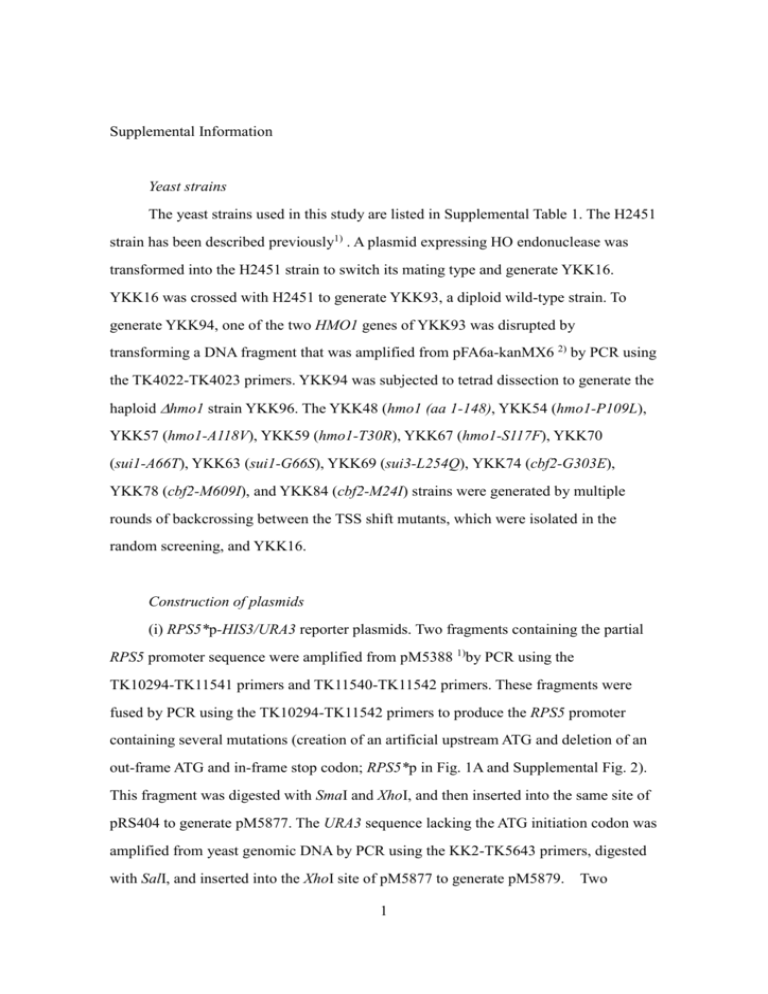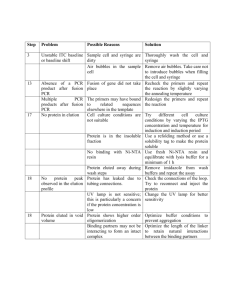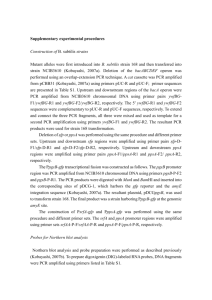Supplemental Information Yeast strains The yeast strains used in
advertisement

Supplemental Information Yeast strains The yeast strains used in this study are listed in Supplemental Table 1. The H2451 strain has been described previously1) . A plasmid expressing HO endonuclease was transformed into the H2451 strain to switch its mating type and generate YKK16. YKK16 was crossed with H2451 to generate YKK93, a diploid wild-type strain. To generate YKK94, one of the two HMO1 genes of YKK93 was disrupted by transforming a DNA fragment that was amplified from pFA6a-kanMX6 2) by PCR using the TK4022-TK4023 primers. YKK94 was subjected to tetrad dissection to generate the haploid hmo1 strain YKK96. The YKK48 (hmo1 (aa 1-148), YKK54 (hmo1-P109L), YKK57 (hmo1-A118V), YKK59 (hmo1-T30R), YKK67 (hmo1-S117F), YKK70 (sui1-A66T), YKK63 (sui1-G66S), YKK69 (sui3-L254Q), YKK74 (cbf2-G303E), YKK78 (cbf2-M609I), and YKK84 (cbf2-M24I) strains were generated by multiple rounds of backcrossing between the TSS shift mutants, which were isolated in the random screening, and YKK16. Construction of plasmids (i) RPS5*p-HIS3/URA3 reporter plasmids. Two fragments containing the partial RPS5 promoter sequence were amplified from pM5388 1)by PCR using the TK10294-TK11541 primers and TK11540-TK11542 primers. These fragments were fused by PCR using the TK10294-TK11542 primers to produce the RPS5 promoter containing several mutations (creation of an artificial upstream ATG and deletion of an out-frame ATG and in-frame stop codon; RPS5*p in Fig. 1A and Supplemental Fig. 2). This fragment was digested with SmaI and XhoI, and then inserted into the same site of pRS404 to generate pM5877. The URA3 sequence lacking the ATG initiation codon was amplified from yeast genomic DNA by PCR using the KK2-TK5643 primers, digested with SalI, and inserted into the XhoI site of pM5877 to generate pM5879. 1 Two fragments containing the partial HIS3 sequence were amplified from yeast genomic DNA by PCR using the KK1-TK11544 and TK11543-TK5854 primers. These fragments were fused by PCR using the KK1-TK5854 primers to produce HIS3 lacking the first and second ATG codons. This fragment was digested with SalI and XhoI, and then inserted into the XhoI site of pM5877 to generate pM5878. The RPS5*p-HIS3 fragment was extracted from pM5878 by digestion with NotI and XhoI, and then inserted into the same site of pRS314 to generate pKM32. The RPS5*p-URA3 fragment was extracted from pM5879 by digestion with SacI and KpnI, and then inserted into the same site of pRS314 to generate pKM39. The RPS5*p-URA3 fragment was again extracted from pKM39 by digestion with SmaI, and then inserted into the same site of pKM32 to generate pKM68 (reporter plasmid containing both RPS5*p-HIS3 and RPS5*p-URA3). (ii) Plasmid used to screen box A mutants. The pM2782 plasmid, which expresses C-terminally FLAG-tagged Hmo1, has been described previously1). The box A region of Hmo1 (amino acids 2–88) in pM2782 was replaced with NcoI and Aor51HI sites by inverse PCR mutagenesis using the KK55-TK11322 primers to generate pKM36. (iii) Plasmids used to express mutant Hmo1 proteins in yeast. The pKM54 plasmid expressing FLAG-tagged Hmo1-T30R in yeast was generated from pM2782 by inverse PCR mutagenesis using the KK49-KK54 primers. Similarly, pKM301 (A118V) and pKM302 (P109L) were generated from pM2782 using the KK193-KK194 primers and KK196-KK197 primers, respectively. The plasmids expressing the FLAG-tagged Hmo1-V35A (pKM96), K25E (pKM97), V17A (pKM99), F37S (pKM100), K13E (pKM101), A31V (pKM102), E22K (pKM103), N39D/K93L (pKM104), F21L/S33P (pKM105), and S18P (pKM106) mutants were recovered from strains that were isolated during screen for box A mutations. 2 (iv) Plasmids used to express Hmo1 in E. coli. The HMO1 ORF was amplified from pM2782 by PCR using the KK148-TK4031 primers. The PCR fragment was digested with NcoI and XhoI, and then inserted into the same site of pET28b to generate pKM193, a plasmid expressing C-terminally His (x6)-tagged Hmo1 (wild-type) in E. coli. Similarly, the ORFs of the hmo1-K13E, V17A, S18P, E22K, K25E, A31V, V35A, F37S, and N39D mutant genes were amplified from pKM101, pKM99, pKM106, pKM103, pKM97, pKM102, pKM96, pKM100, and pKM104, respectively, and inserted into pET28b to generate pKM222, pKM221, pKM226, pKM224, pKM220, pKM223, pKM219, pKM217, and pKM225, respectively. The ORFs of the hmo1-T30R, P109L, S117F, and A118V mutant genes were amplified from genomic DNA extracted from the YKK59, YKK54, YKK67, and YKK57 strains, respectively. These fragments were inserted into pET28b, as described above, to generate pKM253, pKM293, pKM292, and pKM291, respectively. Preparation of biotinylated DNA for in vitro DNA binding assays The biotinylated RPS5 promoter was amplified from pM5388 by PCR using the TK9228-TK9198 primers. The RPS10B promoter was amplified from yeast genomic DNA by PCR using the KK307-TK8980 primers. Biotinylation of this fragment was performed by PCR using the TK9228-TK8980 primers. The UASRPL10-ARS504-Core RPL10 fragment was amplified from pM58653)by PCR using the TK10446-KK300 primers. Biotinylation of this fragment was performed by PCR using the TK10446-TK9228 primers. Purification of the Hmo1 protein The Hmo1 protein was purified from E. coli harboring the pKM193 plasmid, which expresses Hmo1 (wild-type) bearing a His6 tag at the C-terminus. The E. coli cells, which were harvested from 1 L of 2xYT culture medium, were disrupted by sonication in lysis buffer (50 mM NaH2PO4, pH 8.0, 300 mM NaCl, 1 mM PMSF and 5 3 mM imidazole) at 4°C. The clarified cell lysate was then incubated with the Ni-resin (His-accept; Nacalai Tesque) at 4˚C, washed with lysis buffer, and eluted in lysis buffer containing increasing concentrations of imidazole (10–250 mM). 4 Supplemental Figure Legends Supplemental Fig. 1. The effects of the mutations in the HMO1, SUI1, SUI3, and CBF2 genes on the TSS in the endogenous RPS5 promoter. The effects of the mutations identified in the genetic screen on TSS selection in the 5 endogenous RPS5 promoter, as determined by primer extension analyses. The analyses were performed as described in Fig. 2A. The positions of several TSSs, relative to that of the ATG start codon, are indicated. Supplemental Fig. 2. Sequences of the endogenous and modified RPS5 promoter. A. The sequence of a part of the endogenous RPS5 promoter. The arrowhead indicates the major TSS. The underlined nucleotides indicate the nucleotides that were mutated in the RPS5* promoter. B. The sequence of the modified RPS5 promoter (RPS5*p) in the reporter gene, which was used for TSS shift screening. The artificially created start codon is indicated by an asterisk. The amino acid sequence shown below the DNA sequences indicates the polypeptide that was fused with the His3/Ura3 protein when these proteins were translated from the artificial start codon. 6 Supplemental Fig. 3. The method used to screen for mutations in box A of Hmo1 that compromise its ability to bind to its target promoters in vivo. A DNA fragment containing the box A region (amino acids 2–88) was amplified by error-prone PCR using the KK56-KK57 primers (red arrows). In parallel, DNA fragments containing the regions upstream and downstream of box A were amplified by PCR using the TK11321-TK11322 and KK58-KK59 primers (blue arrows), respectively (1st step). Next, the resulting three fragments were fused by PCR using the TK11321-KK59 primers (2nd step), and then co-transformed along with KM36, which contained the HMO1 sequence lacking the box A region (amino acids 2–88), into YKK96 cells (hmo1) containing the RPS5*p + HIS3 (URA3) reporter plasmid (3rd step). To avoid nonsense or frame-shift mutations, colonies that grew on SD -His 7 medium at a faster rate than hmo1 cells containing empty vector were isolated (4th step). Finally, the plasmids were recovered from these strains and sequenced to identify the mutation sites (5th step). Supplemental Fig. 4. The effects of additional mutations in box A on the DNA binding activity of Hmo1 in vitro and in vivo. A. Binding of wild-type and mutant Hmo1 proteins to DNA in vitro (as measured in an immobilized template assay performed as described in the legend to Figure 3C). B. Growth of hmo1 cells containing the RPS5*p + HIS3 (URA3) reporter plasmid and a plasmid expressing the indicated hmo1 mutants. The strains were spotted onto SD +His or SD-His plates and cultured for 5 d at 25°C. 8 Supplemental Fig. 5. The predicted secondary structure of Hmo1. The seven α-helices predicted by PSIPRED are indicated as cylinders on the amino acid sequence. The blue (1st, 2nd, 4th, 5th, and 6th) and gray (3rd and 7th) α-helices were predicted with high and low confidence, respectively. The amino acids shown in red represent those that were mutated, resulting in deficient DNA binding activity of Hmo1. References [1] Kasahara K, Ohtsuki K, Ki S, Aoyama K, Takahashi H, Kobayashi T, Shirahige K, Kokubo T. Assembly of regulatory factors on rRNA and ribosomal protein genes in Saccharomyces cerevisiae. Mol Cell Biol. 2007;27:6686-6705. [2] Longtine MS, McKenzie A, 3rd, Demarini DJ, Shah NG, Wach A, Brachat A, Philippsen P, Pringle JR. Additional modules for versatile and economical 9 PCR-based gene deletion and modification in Saccharomyces cerevisiae. Yeast. 1998;14:953-961. [3] Kasahara K, Ohyama Y, Kokubo T. Hmo1 directs pre-initiation complex assembly to an appropriate site on its target gene promoters by masking a nucleosome-free region. Nucleic Acids Res. 2011;39:4136-4150. 10









